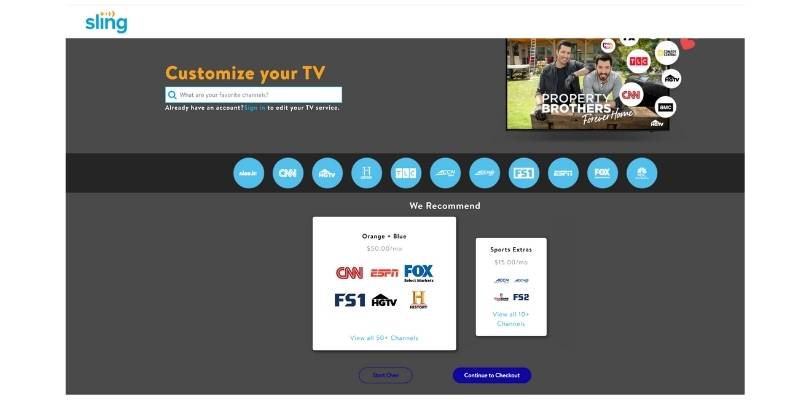The two most important factors when comparing live TV streaming plans are the monthly price and the channel lineup.
But if you’re just starting out, finding the right cable TV alternative can be complicated. That’s because of the way the major live TV streaming services bundle their plans.
Here are some examples:
- DIRECTV STREAM carries Bally regional sports networks that other services have dropped.
- Sling TV is the cheapest way to get ESPN with the Sling Orange plan.
- But if you want to watch cable news, Sling Blue is the least expensive option to get CNN, FOX News and MSNBC.
- Sling TV doesn’t carry all of your local stations.
- And even though YouTube TV has the best overall channel lineup, it’s missing popular networks A&E, History and Lifetime.
- Hallmark is available with Frndly TV starting at just $7 a month.
How to Find the Best Live Streaming TV Bundle
So why all the different lineups? Live TV streaming services have to negotiate with the major content partners like Discovery, ViacomCBS, NBC Universal, Disney and more.
And if the streaming service and content partner can’t agree on a deal, those channels are left out.
In this article, I’ll share several ways to compare streaming TV channel lineups and find the best for you at a monthly price that’s less than cable or satellite TV.
Option 1: Visit Streaming TV Provider Websites
The first way to compare channel lineups is to visit the major live TV streaming services individually: YouTube TV, Hulu Live, Sling TV and the rest.
You can enter your ZIP code and see the list of channels available where you live.
Since you’ll have to visit up to a handful of websites and compare the channel lineups to your list of favorites, this is likely the most time-consuming method.
However, going directly to the service provider will ensure that the channel lineup is accurate.
Option 2: Third-Party Comparison Charts
The second option is to utilize websites that do some of the comparison work for you.
The Streamable is one of those sites. It has a tool where you can enter a network and it will let you know which streaming services offer that particular channel.
However, I don’t like that the Streamable’s tool will sometimes recommend a more expensive bundle.
There’s also CNET. It has a comparison chart that displays the top 100 networks and the live TV streaming services that carry them.
I appreciate that CNET lists the date when the chart was last updated for transparency.
My Perspective
I created and maintained a channel comparison chart for a major website for several years, but it wasn’t easy to keep updated.
When streaming services add channels, they put out news releases or email me directly. But when those same streaming services drop channels, either temporarily or permanently, it’s often done very quietly.
Although some third-party sites are quick to make updates, it’s not a guarantee. But service providers always update channel lists promptly.
Option 3: Start With Sling TV’s Service Optimizer
The third way to compare channel lineups is Sling TV’s Service Optimizer Tool.
This is my personal recommendation. Whether you’re considering Sling TV or not, this is a great place to visit when you’re reviewing channel lineups to see if streaming will work for you.
Here’s how to use it:
- Put together a list of favorite broadcast and cable channels for everyone in your household.
- Enter the channels into Sling TV’s Service Optimizer Tool.
- Compare the recommended bundle and starting price to YouTube TV and other services.

If the Sling TV bundle that’s recommended for your household is cheaper than YouTube TV and Hulu Live, you may want to take a serious look at Sling TV.
But know that Sling TV offers limited local channels. You’ll need an antenna.
Other Services to Consider
If you received a “Channel Not Found” message when using the Sling TV tool, it’s time to move on to see if other services have all of your must-have channels.
I suggest starting with YouTube TV because it has the best overall channel lineup.
From this point, the process is the same as the first option. Go to tv.youtube.com and enter your ZIP code to see if your favorite channels are offered.
If you’re still not finding everything on your list, move on to Hulu Live, fuboTV or maybe even DIRECTV STREAM and check their channel lineups.
Don’t watch sports or news? Consider Philo for entertainment and lifestyle networks.
Comparing Other Features
There’s also the possibility that multiple live TV streaming services will carry all of your must-have channels.
In that case, you can either go with the lowest price or consider other features like cloud DVR storage, supported devices, multiple streams and the user interface.
But when you’re just starting out your research, keep it simple. Focus on the pricing and the list of channels first.
If you want to learn more about the best live TV streaming services, I have a guide for beginners that I’ve written based on five years of testing the major services. Get started here.
I also invite you to check out my YouTube channel for more ways to save on cutting the cord!

I just switched to DIRECTV because of their great live TV streaming plans.